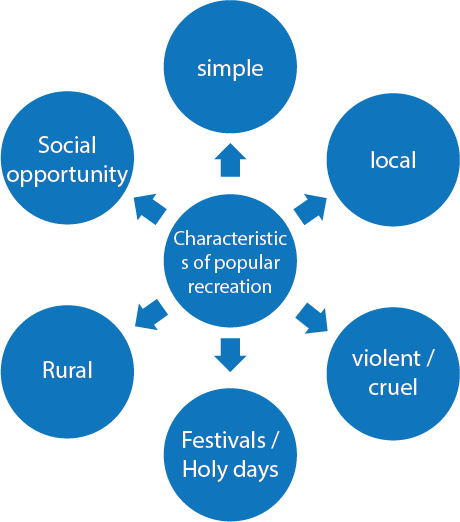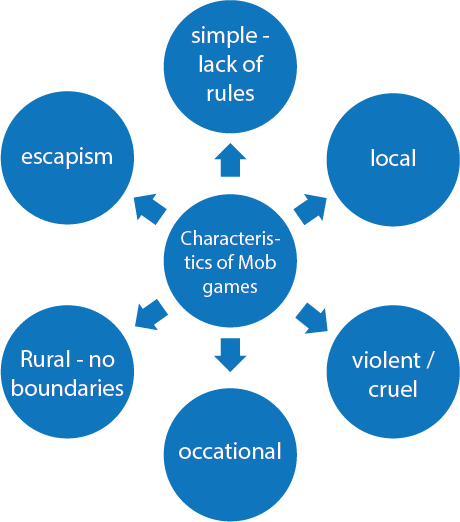Content
- Role of sport in society
- Amateurism to professionalism
Modern day sport has been shaped by the past. Looking back into history it is clear to see the origins of our most popular sports and leisure activities

Pre industrial revolution recreational activities were split between the peasants and gentry. The peasants took part in recreational activities at annual festivals, fairs and holidays (Christmas). The church at the time was opposed to many sports and pastimes. The gentleman needed to be both sporting and cultural in gentry’ circles. These sporting activities included: hunting, real tennis and dancing.

By the 17th Century mob games and baiting had become pastime activities (as long as church attendance continued. In the 18th Century the church provided feast days and spaces for gatherings, cricket, horse racing and bare-fist fighting (Broughton rules in 1743) were popular and became attractions for SPECTATORS and the early beginning of COMMERCIALISATION.
During the 19th Century, society, education, sports and games dramatically changed. Society was founded on Christianity and a Protestant work ethic. Work standards and hours began to improve for the working classes, and with the industrial revolution came the improvement in transport links and the further development of sport. Also with the creation of the British Empire came the development of Sport across the world.
Characteristics of popular recreation

Mob ball was a popular recreation game. Variations in this game involved kicking and throwing a ball in English pre-industrial society. Mob football was little more than massive brawls involving brute force between hoards of young men.
Gentry, government and local authorities have frowned on mob games because they caused:
Shove Tuesday became a traditional day for mob games, seen as an opportunity for fun and excitement before the seriousness of Lent.

These schools were controlled by a group of trustees and were not privately owned. The main characteristics of these schools were; boarding allowing more time for recreational activities; they brought boys from a variety of regions and therefore regionalised games; the harsh treatment and living conditions prepared boys for rigorous competition (Spartan).
Dr Thomas Arnold is regarded as the man who reformed the English public school system. Dr Arnold’s aim was to preach good moral behaviour. This was part of Muscular Christianity movement, with the belief in a healthy mind, soul and fit body.
Arnold reformed public schools by changing the behaviour of the boys, developing the role of Sixth formers and creating the importance of healthy minds and bodies. The use of games organised by the sixth formers established social control, it created positive role models and leadership opportunities.
House system
This is the predecessor of the creation of leagues and codification of games. Arnold’s house system became the focus of boy’s personal, social, recreational and sporting existence. The house system allowed healthy competition, a sense of belonging and cohesive attitudes.
As Public Schools developed in popularity so did the funding and the development of magnificent games fields, uniforms and rules. Interschool competitions brought about the symbols of athleticism. Athleticism reached cult proportions with schools having compulsory games for the development of character.
Athleticism – the combination of physical effort and moral integrity (sportsmanship)
These students then went onto University taking the ‘games ethic’ with them; well rounded character, impeccable manners and enviable personal qualities. Having led a team on the games field, it was assumed that he could lead a regiment on the battlefield. These students would also bring the rules and conventions from a variety of schools to begin to formalise agreed rules more centrally.
The speed of athleticism development was much slower in girl’s public schools due to:
By the late 19th Century Sports Days had become a major social occasion and a symbol of a more modern age. Sports days represented a more technical era and a developing interest in skilfulness over brute force. These sports days were highly organised with elaborate programmes.
Football became more codified and central part of not just public schools but also society. The upper classes saw it as a respectable activity that showed courage and determination.
Association Football
Similarly Cricket In the 1870’s developed from touring XI’s to county cricket s as a spectator attraction – while county communities needed and respected professionals, they kept them firmly in their social place e.g. the Players v Gentleman or Pro’s v Amateurs, they even had different eating arrangements and did not even travel to matches together or share a changing room.
Background:
The army was rejecting over a third of recruits on physical grounds by the late 19th Century. Little space or facilities in industrial towns or emphasis in state schools. Drill was introduced to improve fitness for army recruits, discipline and to attempt to do for working –class children what games was doing for the public school boys.